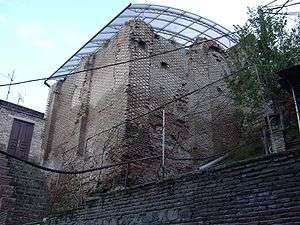Atashgah of Tbilisi

The Atashgah, also transcribed as 'Ateshgah (Georgian: ათეშგა Persian: آتشگاه) is an ancient Zoroastrian temple in Tbilisi, Georgia. It was built when Georgia was a part of Persian Empire in Sasanian era (224-651 AD). The name “Ateshga” originates from the Persian “Ateshgah” which means the place for fire.[1]
Atashgah is located around 100 meters east of the Holy Mother of God Church of Bethlehem, on the Old Town slopes northeast of the Mother Georgia statue. It is an ancient brick building with a protective curved perspex roof. The temple is one of the oldest religious buildings in the Georgia’s capital located in the historic part of the city.[2]
The Atashgah has been preserved because it has been discreetly camouflaged in the city. There is little information as to when it was built, but some historians refer to it as having been built in the Sassanian era. During the wars between Persians and Turkish Muslims, Tbilisi fell into Turkish hands and the church was temporarily turned into a mosque. Lately some Turks have tried to restore the Atashgah into an active mosque. The Government of Georgia agreed, on the condition that the mosque would not be active. The parties did not agree and this is where we entered the Arena. On 16 September 2013 the Zonouzi family entered the church, with the agreement of the keeper of the Atashgah. The Fire of Ahura Mazda (Armazi in Georgian) was set alight, with prayers, and Zoroastrian ceremonies were held.
Since 2007 Norwegian government is supporting a project to restore Atashgah.[3]
References
External links
| Wikimedia Commons has media related to Atashgah of Tbilisi. |
Coordinates: 41°41′20″N 44°48′20″E / 41.68885°N 44.80559°E